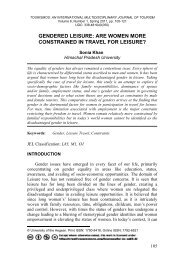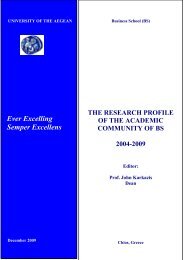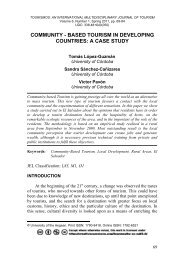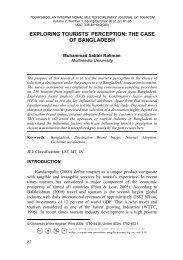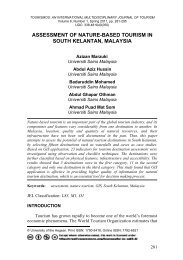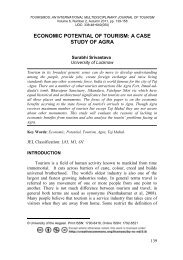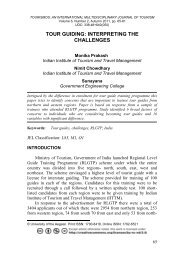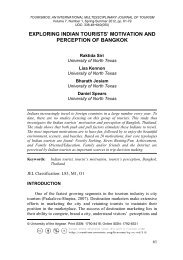TOURISMOS is an international, multi-disciplinary, refereed (peer ...
TOURISMOS is an international, multi-disciplinary, refereed (peer ...
TOURISMOS is an international, multi-disciplinary, refereed (peer ...
You also want an ePaper? Increase the reach of your titles
YUMPU automatically turns print PDFs into web optimized ePapers that Google loves.
<strong>TOURISMOS</strong>: AN INTERNATIONAL MULTIDISCIPLINARY JOURNAL OF TOURISM<br />
Volume 6, Number 1, Spring 2011, pp. 141-163<br />
UDC: 338.48+640(050)<br />
in resident populations induced by second home tour<strong>is</strong>m. M<strong>an</strong>aging<br />
seasonality <strong>is</strong> a challenge for the whole tour<strong>is</strong>m sector. Especially the<br />
over- <strong>an</strong>d underutil<strong>is</strong>ation of services during certain periods, the huge<br />
traffic congestion <strong>an</strong>d water consumption during the peak season <strong>an</strong>d<br />
exclusively temporary employment are problems that need to be<br />
m<strong>an</strong>aged. Additionally, the vac<strong>an</strong>t second homes are at r<strong>is</strong>k of burglary.<br />
In second home tour<strong>is</strong>m there <strong>is</strong> also the problem that the considerable<br />
increase in the population during certain periods <strong>is</strong> usually neglected in<br />
official population stat<strong>is</strong>tics.<br />
Another m<strong>an</strong>agement <strong>is</strong>sue <strong>is</strong> the response of second home owners to<br />
development, <strong>an</strong>d how they c<strong>an</strong> be included in pl<strong>an</strong>ning dec<strong>is</strong>ions. For<br />
national governments it <strong>is</strong> a challenge to m<strong>an</strong>age the situation that<br />
nowadays m<strong>an</strong>y people have <strong>multi</strong>ple homes, <strong>an</strong>d w<strong>an</strong>t to participate not<br />
only in the development of their first residence. By establ<strong>is</strong>hing a local<br />
association that enables the second home owner to act as a partner of the<br />
local authorities in pl<strong>an</strong>ning <strong>is</strong>sues, the local government c<strong>an</strong> comply with<br />
th<strong>is</strong> trend of <strong>multi</strong>ple homes.<br />
POLICY RESPONSES<br />
As stated by Gallent et al. (2005), policies should attempt to absorb<br />
the dem<strong>an</strong>d for second homes while at the same time directing that<br />
dem<strong>an</strong>d away from those communities which are at r<strong>is</strong>k from the<br />
intrusions. Th<strong>is</strong> would be achieved by identifying sites suitable for<br />
purpose-built second home developments <strong>an</strong>d using development control<br />
to d<strong>is</strong>courage developments in unsuitable areas. Pl<strong>an</strong>ning authorities<br />
direct second homes into certain settlings where their impact <strong>is</strong> beneficial<br />
rather th<strong>an</strong> damaging. For example they c<strong>an</strong> be used to ass<strong>is</strong>t the<br />
preservation of h<strong>is</strong>toric or other properties which would otherw<strong>is</strong>e fall<br />
derelict or be neglected. Another policy option might be to promote<br />
second home ownership in such a way as to maxim<strong>is</strong>e economic benefits,<br />
whilst diverting dem<strong>an</strong>d away from ex<strong>is</strong>ting housing stock.<br />
Promoting economic <strong>an</strong>d social development at the local <strong>an</strong>d national<br />
level <strong>is</strong> seen as the best long-term mech<strong>an</strong><strong>is</strong>m for bringing the housing<br />
<strong>an</strong>d employment ch<strong>an</strong>ces of rural households into parity with their urb<strong>an</strong><br />
counterparts. Because some locals fall into the “low income – low<br />
wealth” consumption class, they may not be able to successfully compete<br />
for market housing against more prosperous incomers; it follows that one<br />
solution <strong>is</strong> to provide non-market alternatives. However th<strong>is</strong> <strong>is</strong> often<br />
difficult to realize because of insufficient funding <strong>an</strong>d a lack of<br />
commitment to a comprehensive rural housing programme. The<br />
147



